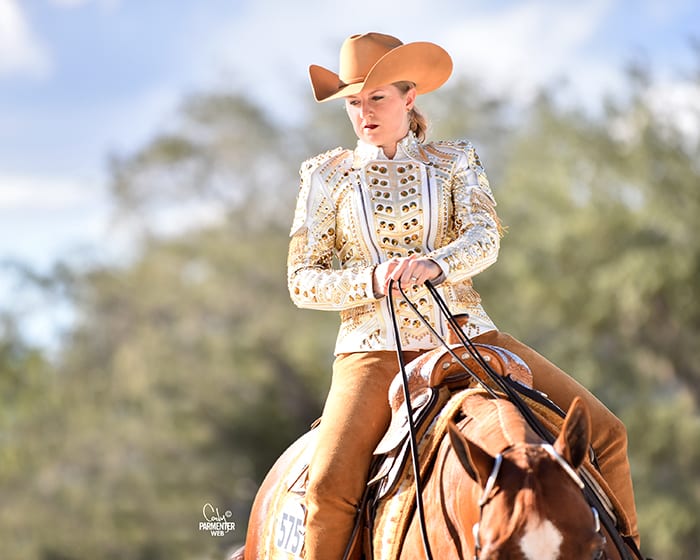Many all-around exhibitors are well versed in the disciplines of showmanship, equitation, horsemanship, and western riding. As riders, there’s a thrill in adding a new class and learning new skills with your equine partner. Given trail’s steady rise in popularity, now more than ever, many competitors are adding the class to their show resume. GoHorseShow spoke with a few pros and amateurs about what it takes to find your stride in the trail arena.
Amateur exhibitor Katie Grossnickle of Maple City, Michigan, has been a fixture in the trail arena since 2003. She got her start on the mare, Prettiest Blaze Yet, who was already a trail veteran. “She took me through quite a few trail classes before I knew what I was doing,” says Grossnickle. “Early on, I didn’t know how to count strides. She took care of me while I figured it out.”
The combination of a horse that knows the class and an amateur that’s eager to learn is what most pros see as the best combination for a successful introductory trail partnership. Grossnickle agrees, saying, “Starting out, Prettiest Blaze Yet was so beneficial as a partner. I could put her in bad spots, and she’d still help me. Having one that knows what they’re doing while you’re starting out is the way to go.”
Today, Grossnickle shows with Brent Maxwell of Mil-Max Training Center (pictured below right). She shows her two horses—Always the Best Man and Always Lopin Sober—in performance halter, horsemanship, western riding, and trail. In 2016, Katie and Always Lopin Sober placed in the top ten in Amateur Horsemanship at the AQHA World Show.
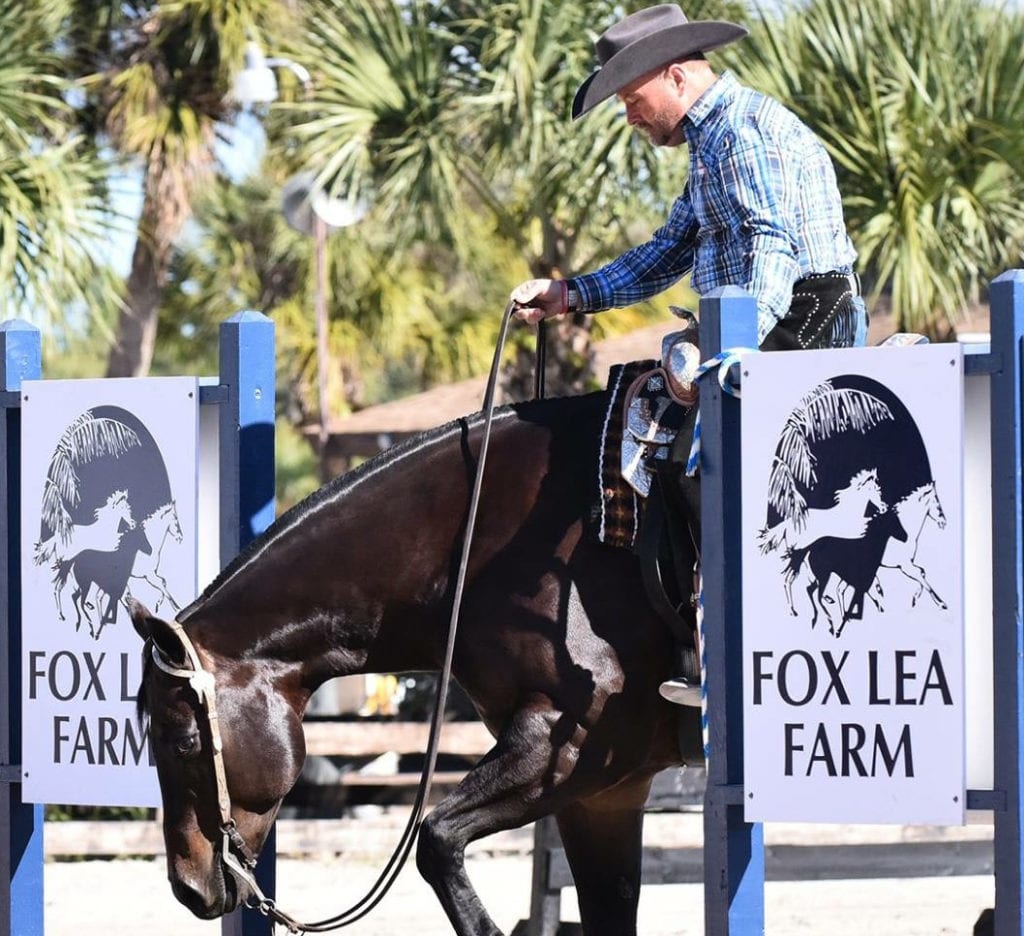 Grossnickle urges riders not to be discouraged by the precision that trail requires because, once you’re through the learning stage, that precision is what makes the class so rewarding. She says, “Trail can be frustrating when you’re starting to learn, but stick with it. Having a horse that knows the class is a huge help.”
Grossnickle urges riders not to be discouraged by the precision that trail requires because, once you’re through the learning stage, that precision is what makes the class so rewarding. She says, “Trail can be frustrating when you’re starting to learn, but stick with it. Having a horse that knows the class is a huge help.”
AQHA Professional Horsewoman Whitney Lagace of Higganum, Connecticut, agrees with Grossnickle, in that, the best way for a rider to learn trail is a seasoned horse. “I tell people interested in starting trail to take some lessons on a broke trail horse,” says Lagace. Lagace, who has won World, Congress, and NSBA World titles in the trail, believes that it’s difficult to teach both horse and rider the ins and outs of the class at the same time. “In an ideal world, we take an all-around horse with potential for the trail and I show the horse for a year while the owner either takes lessons on a seasoned trail horse or leases and shows a horse that knows the class,” says Lagace. In her opinion, it takes a trainer a year to teach the horse and give them the show mileage necessary to teach the rider.
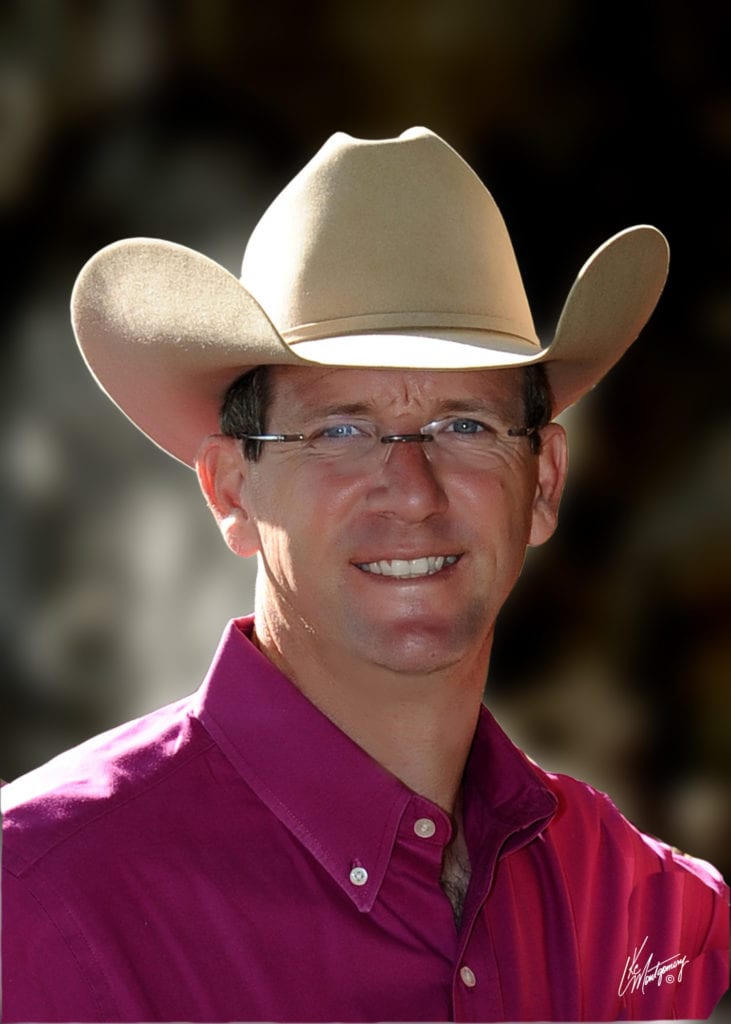 AQHA Professional Horseman Robin Frid (pictured left) also believes that a scenario in which the horse primarily shows the rider is the best possible setup for trail success. Frid and his wife, Jenny, specialize in training horses for all-around competition in Denton, Texas. Like Lagace, Frid says that green and green is rarely a good combination for learning trail. “In most cases, I like a scenario where the horse can help the rider learn.”
AQHA Professional Horseman Robin Frid (pictured left) also believes that a scenario in which the horse primarily shows the rider is the best possible setup for trail success. Frid and his wife, Jenny, specialize in training horses for all-around competition in Denton, Texas. Like Lagace, Frid says that green and green is rarely a good combination for learning trail. “In most cases, I like a scenario where the horse can help the rider learn.”
Amateur exhibitor Beckie Peskin, who rides with Frid, followed that model with her horse, Dont Skip Will or “Niko.” She says, “Robin started showing him in the trail as a three-year-old, but I didn’t start showing him until he was five.” Peskin, who hails from Roswell, Georgia, has competed in all-around classes like showmanship, horsemanship, and equitation since her youth days.
Peskin says that watching Frid show the horse in trail and seeing the horse’s ability made her want to try the class herself. “It was intriguing but scary to me,” says Peskin. “I knew that taking on the trail would be a big challenge. But, throughout the process, I’ve learned that the mindset for the trail is different than for all of my other classes. Trail forces you to slow your brain down and stay in one obstacle. That’s been tough for me as a rider.”
 Despite the challenge, Peskin (pictured right) will tell you that the patience required in trail has benefited all of her other classes. “Learning to take my time was huge. I was a big run horsemanship kind of girl. I like to spin fast and trot hard, but you can’t approach trail that way. Niko just wants to go slow. In the beginning, I was trying to steer him like a sports car, but he’s more of a Buick. Allowing him to take three moves instead of one is something we’ve learned in the trail that has helped our horsemanship tremendously.” She adds, “In trail, you can’t be demanding of the horse. You have to slow down, release some control, and realize that sometimes the pattern won’t go exactly as you’d planned. I’ve learned that if I take off a stride late, it will still probably be okay.”
Despite the challenge, Peskin (pictured right) will tell you that the patience required in trail has benefited all of her other classes. “Learning to take my time was huge. I was a big run horsemanship kind of girl. I like to spin fast and trot hard, but you can’t approach trail that way. Niko just wants to go slow. In the beginning, I was trying to steer him like a sports car, but he’s more of a Buick. Allowing him to take three moves instead of one is something we’ve learned in the trail that has helped our horsemanship tremendously.” She adds, “In trail, you can’t be demanding of the horse. You have to slow down, release some control, and realize that sometimes the pattern won’t go exactly as you’d planned. I’ve learned that if I take off a stride late, it will still probably be okay.”
Peskin’s other trail takeaway? “Trail is about riding the in-between as much as it’s about riding the obstacles. It’s also about patience, and that’s something that’s helped me become a better rider.” For Peskin, the victories she’s celebrated most have nothing to do with titles. “I truly get excited when I conquer an obstacle that’s given me trouble. Having a great run is always exciting.”
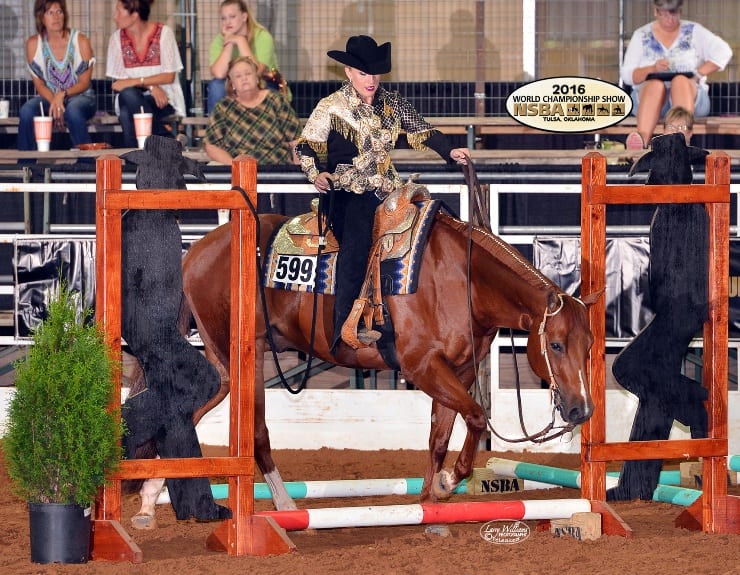 Libby Rinder is a longtime client of Whitney Lagace. In 2010, Lagace won her first World Championship in Junior Trail aboard Rinder’s gelding, Hot Rockin Potential, also known as “Sonny.” Rinder also owns a four-year-old mare, Rockin In The Blues, or “Stella.” Lagace showed the mare to a win in the Three-Year-Old Trail at the 2016 NSBA World Show.
Libby Rinder is a longtime client of Whitney Lagace. In 2010, Lagace won her first World Championship in Junior Trail aboard Rinder’s gelding, Hot Rockin Potential, also known as “Sonny.” Rinder also owns a four-year-old mare, Rockin In The Blues, or “Stella.” Lagace showed the mare to a win in the Three-Year-Old Trail at the 2016 NSBA World Show.
Rinder (pictured left) competes with Sonny in western riding and trail. As a rider that focuses mostly on the trail, Rinder says that her affinity for the class comes in the constant challenge. “In trail, there are always new obstacles, new patterns, and new combinations. I love that my horse and I are challenged.”
Though Rinder and Sonny have been partners for some time, she just started showing Stella. She shares that showing a young horse has forced her to go back to the basics. “I just started showing Stella in Florida,” says Rinder. “I realize that with a young horse you have to be more aware; I find myself steering more and helping her. It’s made me tighten my skills and go back to the basics.” She adds, “A young horse won’t save you the way a seasoned horse will. But, that forces me to be better, to slow down, and to communicate with the horse. It’s one of the reasons I love trail so much.”
Showing a young horse has also improved Rinder’s relationship with her trusted partner. “I find that with Sonny, I’m going back and working on developing our rhythm and flow through each obstacle. That helps in the western riding pen too.”
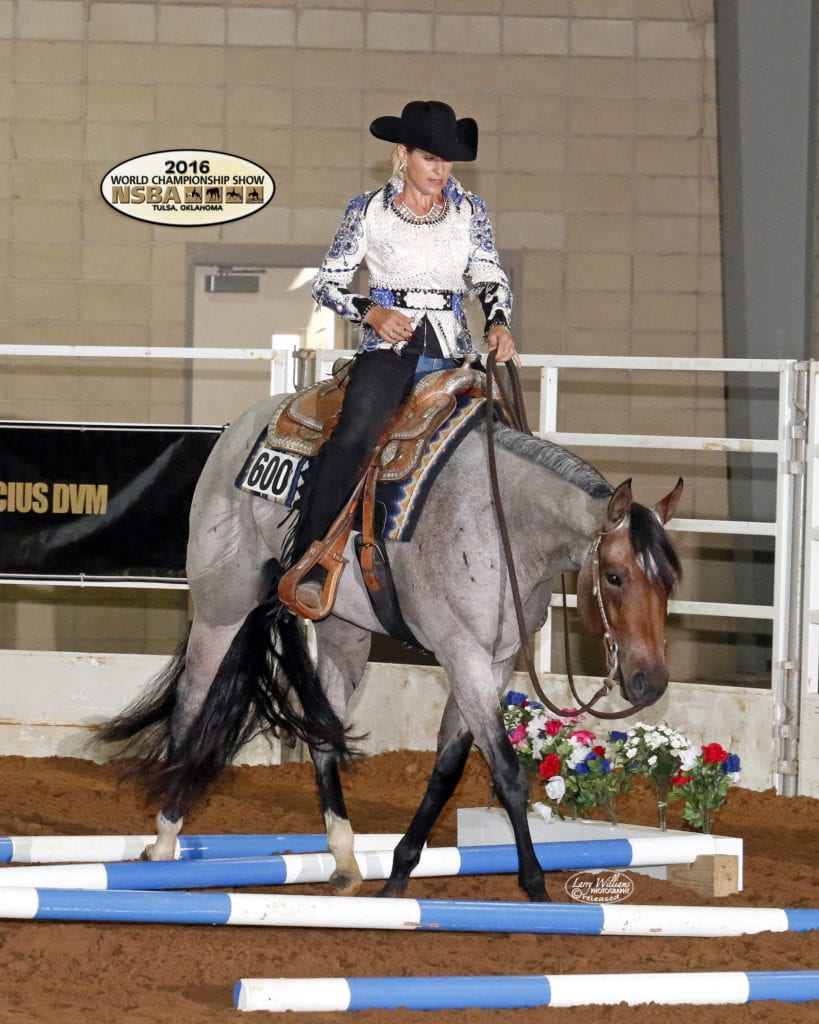 As a rider, there are skills required in the trail pen that are not found in the all-around arena. Lagace says, “One of the biggest things for a rider learning trail is training the eye to see distance. Through practice, you learn how to approach the poles appropriately and see when you’re two or three strides out. Very few people know that off the bat.” Lagace adds that acquiring these skills are why a broke horse is essential. “A seasoned horse will help you find those distances. You’ll learn to understand why a horse reaches or rates back.”
As a rider, there are skills required in the trail pen that are not found in the all-around arena. Lagace says, “One of the biggest things for a rider learning trail is training the eye to see distance. Through practice, you learn how to approach the poles appropriately and see when you’re two or three strides out. Very few people know that off the bat.” Lagace adds that acquiring these skills are why a broke horse is essential. “A seasoned horse will help you find those distances. You’ll learn to understand why a horse reaches or rates back.”
Frid thinks that there are many skills a seasoned, all-around rider can bring to the trail. “The ability to shape a pattern and knowing how to use the space in the arena to your advantage are essential skills.” He adds, “All-around riders also understand the need for rhythm and have the ability not to be a passenger; they can communicate with their horse the and handle them.”
He goes on to say that one thing many all-around riders will likely come to appreciate about the trail is the freedom to take their time through obstacles. “Once you’re ready to show, don’t be afraid to check in with your horse. Take those opportunities to close your feet and take a breath. In the trail that’s okay.”
Are you thinking about trying your hand at trail? Our riders and trainers offer this advice:
Beckie Peskin: Don’t be intimidated and know that you’ll flub it up sometimes. If you try it, you’ll find it’s pretty dang fun.
Robin Frid: Be patient. Have tough skin. And don’t get discouraged. Take things one obstacle at a time and don’t panic if things go wrong.
Libby Rinder: Spend your time in practice and don’t be surprised if the stimulation is overwhelming at first…for you and your horse.
Whitney Lagace: Go for it. You just might become addicted.
Katie Grossnickle: Don’t be surprised if you’re frustrated at first. Find a broke horse to learn on and stick with it.
Photos © Cody Parmenter, Larry Williams, Beckie Peskin, KC Montgomery


